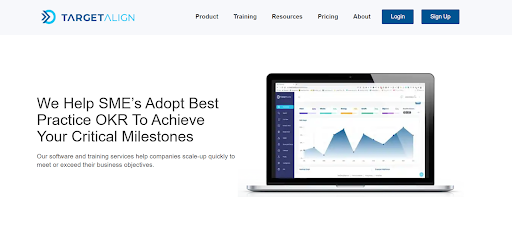How Target Align Makes OKR Quarterly Reviews More Effective for Small Teams
Setting ambitious goals is a hallmark of high-performing organizations, but achieving them consistently is where the real challenge lies. This is where top OKR tools come in. OKR (Objectives and Key Results) is a proven starategy that bridges the gap between planning and execution. Popularized by tech giants like Google, Airbnb, and Intel, OKRs have become the benchmark for driving focus, alignment, and measurable progress across teams. But the magic of OKRs tracking software is in regularly reviewing them to ensure they’re moving the needle in the right direction.

OKR review is a way to reflect on past performance, identify roadblocks, and realign priorities for the next quarter. In this guide, we’ll walk you through the step-by-step process of conducting effective OKR quarterly reviews, helping you maximize the impact of your goals and keep your teams on the path to success.
Why Are OKR Quarterly Reviews Important?
OKR quarterly reviews are more than just routine checks. They provide a critical opportunity to:
- Assess progress: Understand how far you’ve come toward achieving your objectives.
- Identify roadblocks: Pinpoint what’s holding you back before it’s too late.
- Realign priorities: Shift focus if market dynamics or company goals have changed.
- Boost accountability: Keep teams motivated and committed to their goals.
- Drive continuous improvement: Learn from successes and failures to refine your approach.
How to Conduct an Effective OKR Quarterly Review
Conducting a meaningful OKR quarterly review involves a series of well-defined steps or some of the top OKR tools like Target Align. It’s about deeply understanding your progress, learning from challenges, and setting the tone for future success.
- Gather the right data
Before diving into the review process, it’s important to gather the right data. This includes quantitative metrics like key result completion rates, financial performance, and customer satisfaction scores, as well as qualitative insights from team feedback.
The goal is to have a comprehensive view of how each objective is tracking. To streamline this data collection, consider using top OKR tools like Target Align’s dashboard or other automated OKR tracking software.
2. Evaluate OKR progress
Once you have the data, it’s time to evaluate your progress. This step involves a critical assessment of each objective and its corresponding key results. Reflect on what went well, where you fell short, and why certain goals might not have been fully achieved.
It’s important to approach this phase with an open mind, focusing not just on the numbers but also on the underlying reasons for success or setbacks. Top OKR tools and real-time OKR tracking software can reveal hidden insights, like communication gaps or resource shortages, that might be impacting overall performance.
3. Reassess OKR relevance
Not all OKRs remain relevant throughout a quarter. External factors like market shifts, changing customer needs, or internal strategy can impact their importance. Use this opportunity to reassess each objective’s relevance. If a particular OKR no longer aligns with your company’s current goals, consider adjusting or even dropping it.
During the process, you might discover new priorities that deserve attention in the next quarter. This step is crucial for keeping your teams aligned with the broader strategic direction and improved 360-degree goal setting.
4. Plan for the next OKR quarterly review
After reflecting on past performance, it’s time to plan for the next quarter. Use your insights to adjust your goals, reset key results, and realign resources if needed. This might mean tightening your focus, refining your metrics, or setting more ambitious targets based on lessons learned.
Effective planning at this stage sets the tone for the upcoming quarter and ensures that everyone is on the same page.
5. Documentation and sharing
Finally, transparency is key to a successful OKR system. Clearly document the outcomes of your review, including lessons learned, new goals, and any necessary adjustments. Sharing this information with your broader team creates a culture of collaboration and accountability, so that everyone understands their role in the company.
For better team alignment, consider using OKR software for startups, where teams are usually small and growing. Target Align offers one of the best OKR tracking software solutions, with real-time insights to achieve better business results.
Best Practices for OKR Quarterly Reviews
Remember some of these tips during OKR quarterly reviews:
- Use clear metrics to assess progress and project management.
- Don’t get bogged down in day-to-day tasks. Always keep the focus on long-term goals.
- Encourage teams to share challenges or roadblocks openly for better discussions and solutions.
- Recognize achievements to improve morale and reinforce a culture of success within the teams.
- Use setbacks as learning experience to improve your OKR strategy in the future.
Wrapping Up: Keep Your Goals on Track
Regular OKR quarterly reviews are the backbone of strategic success. They keep your teams focused, agile, and aligned with the bigger picture. Whether you’re scaling a startup or managing a large enterprise, these reviews are essential for maintaining momentum and achieving impactful results.
Ready to supercharge your goal-setting? Start your OKR journey with Target Align and keep your teams on track every quarter. If you’re interested in learning more about OKRs and its implementation, visit www.targetalign.com and sign up for Target Align’s video course.

